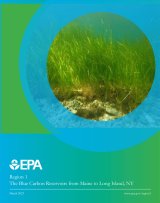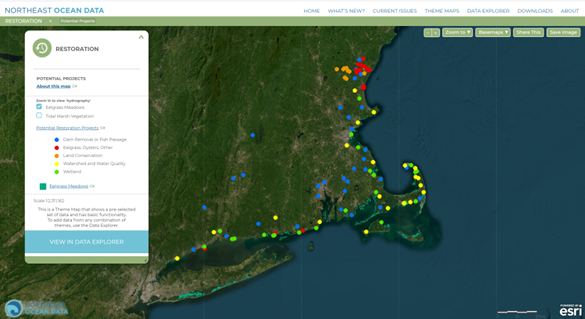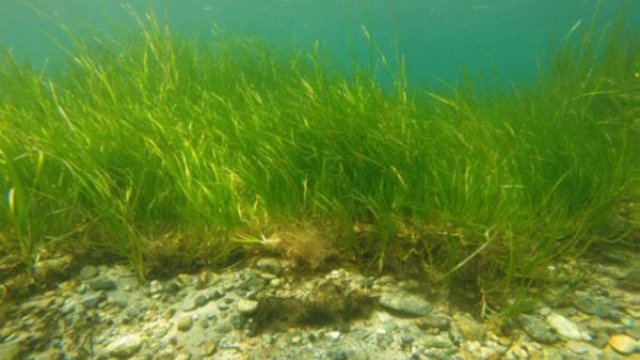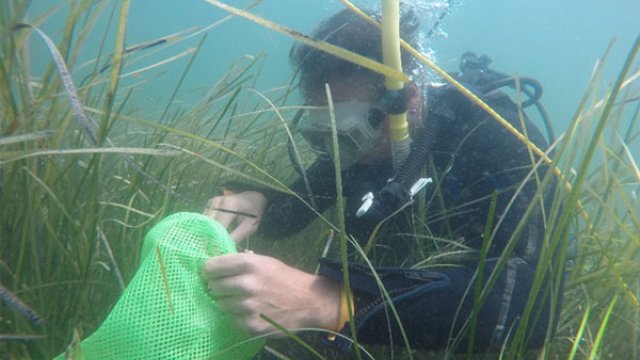Blue Carbon in New England
On this page:
Introduction
Blue carbon is the term used to describe carbon stored in coastal and marine salt marshes, seagrass, and mangroves. These aquatic habitats are much more efficient at accumulating/sequestering carbon than terrestrial habitats. An acre of forest will have less sequestered carbon in its soil than the equivalent acre of seagrass, salt marsh or mangrove. New England has a high proportion of coastal and marine salt marsh environments that currently support, or potentially could support healthy salt marsh, seagrass or mangrove environments.
2023 Blue Carbon Report

In March 2023 EPA published a report "The Blue Carbon Reservoirs from Maine to Long Island, NY" documenting a multi-year study undertaken by EPA in coordination with many other federal, state, academic, and other non-governmental scientists and technical experts to document the existence and status of blue carbon sequestering environments along the northeastern coastal areas including Maine, New Hampshire, Massachusetts, Connecticut, and Long Island in New York State.
Why was this study conducted?
In 2001, the governors of the New England states (Connecticut, Maine, Massachusetts, New Hampshire, Rhode Island, and Vermont) and the premiers of the five eastern Canadian provinces (New Brunswick, Newfoundland and Labrador, Nova Scotia, Prince Edward Island, and Quebec) adopted a regional Climate Change Action Plan (CCAP) (pdf) . The plan set ambitious greenhouse gas emission reductions goals (10% below 1990 levels by 2020) and looked to reduce climate change impacts by adaptation. In 2015, the governors and premiers signed a resolution to further reduce greenhouse gas emissions to 35-45% below 1990 levels by 2030 (pdf) .
During the 2017 Conference of New England Governors and Eastern Canadian Premiers (pdf) , the management of "blue carbon resources to preserve and enhance their existing carbon reservoirs" was identified as a possible regional climate change action to mitigate and reduce greenhouse gases.
Seagrasses, salt marshes, and mangroves are the aquatic habitats most associated with the term blue carbon, which is the carbon sequestered in vegetated coastal habitats. All plants accumulate carbon through their normal growth processes, but these three habitats can sequester carbon in the sediments for decades to centuries.
In June 2020, EPA Region 1 initiated an effort to establish a baseline of New England's blue carbon inventory. Working with New England state and federal (USGS and USDA) agencies, academic experts, and non-governmental organizations and utilizing a contract with the Northeast Regional Ocean Council (NROC), datasets of New England's eelgrass meadows and salt marsh habitats (current and historic) and marine soil cores were identified and entered into an interactive map on the Northeast Ocean Data Portal. Soil organic carbon stocks within these marine habitats were also used to calculate blue carbon stocks.
The resulting study, published in March 2023, is an initial effort to provide a quantitative baseline of the existing blue carbon reservoirs for the geographic region spanning the northernmost point in Maine to the southern shores of Long Island, New York.
Key Findings
The target geographic area has an estimated 218,222 acres of eelgrass meadows and salt marsh, which are estimated to provide a reservoir of 7,523,568 megagrams of blue carbon. Using the EPA greenhouse gas equivalency calculator, this quantity of stored carbon is equivalent to:
- The emissions from 5,994,024 passenger vehicles driven in one year.
- The burning of 30,521,000,000+ pounds of coal.
- The emissions associated with the energy use of 3,474,000 homes for a year.
- The emissions offset by the operation of 7,498 wind turbines for a year.
- The quantity of carbon accumulated in one year in 32,646,000 acres of upland forest.
Sequestered carbon in New England is predominately from salt marsh habitats, which is a habitat type at great risk due to sea level rise and coastal development.
Multimedia Gallery
Collaboration
The New England Aquarium, Boston, MA, developed an educational exhibit about blue carbon opening in early 2024. The New England Aquarium has consulted with EPA on information about the importance of blue carbon, such as background materials, history, and state and EPA initiatives to protect blue carbon stocks.
Northeast Ocean Data
For visual display purposes, sediment carbon heat maps were developed to highlight areas of greatest carbon accumulation. The habitat distribution and sediment carbon heat maps can be accessed on the Northeast Ocean Data Portal which is a public source of expert-reviewed, interactive maps and data on the ocean ecosystem, economy, and culture of the northeastern United States and can be used to facilitate decision making by government agencies, tribal nations, businesses, non-governmental organizations (NGOs), academic institutions, and individuals.





